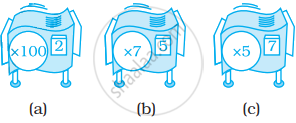Advertisements
Advertisements
प्रश्न
The table shows the mass of the planets, the sun and the moon in our solar system.
| Celestial Body |
Mass (kg) | Mass (kg) Standard Notation |
| Sun | 1,990,000,000,000,000,000,000,000,000,000 | 1.99 × 1030 |
| Mercury | 330,000,000,000,000,000,000,000 | |
| Venus | 4,870,000,000,000,000,000,000,000 | |
| Earth | 5,970,000,000,000,000,000,000,000 | |
| Mars | 642,000,000,000,000,000,000,000,000,000 | |
| Jupiter | 1,900,000,000,000,000,000,000,000,000 | |
| Saturn | 568,000,000,000,000,000,000,000,000 | |
| Uranus | 86,800,000,000,000,000,000,000,000 | |
| Neptune | 102,000,000,000,000,000,000,000,000 | |
| Pluto | 12,700,000,000,000,000,000,000 | |
| Moon | 73,500,000,000,000,000,000,000 |
- Write the mass of each planet and the Moon in scientific notation.
- Order the planets and the moon by mass, from least to greatest.
- Which planet has about the same mass as earth?
उत्तर
a. Mass of each planet and Moon in scientific notation is given below:
Using law of exponents, am × an = am + n
Sun = 199 × 1028
= 1.99 × 1028 × 102
= 1.99 × 1030
Mercury = 33 × 1022
= 3.3 × 1022 × 10
= 3.3 × 1023
Venus = 487 × 1022
= 4.87 × 1022 × 102
= 4.87 × 1024
Earth = 597 × 1022
= 5.97 × 1022 × 102
= 5.97 × 1024
Mars = 642 × 1027
= 6.42 × 1027 × 102
= 6.42 × 1029
Jupiter = 19 × 1026
= 1.9 × 1026 × 10
= 1.9 × 1027
Saturn = 568 × 1024
= 5.68 × 1024 × 102
= 5.68 × 1026
Uranus = 868 × 1023
= 8.68 × 1023 × 102
= 8.68 × 1025
Neptune = 102 × 1024
= 1.02 × 1024 × 102
= 1.02 × 1026
Pluto = 127 × 1020
= 1.27 × 1020 × 102
= 1.27 × 1022
Moon = 795 × 1020
= 7.95 × 1020 × 102
= 7.95 × 1022
b. Order of mass of all planets and Moon from least to greatest
Pluto < Moon < Mercury < Venus < Earth < Uranus < Neptune < Saturn < Jupiter < Mars
c. Venus has about the same mass as Earth.
APPEARS IN
संबंधित प्रश्न
The table shows the average distance from each planet in our solar system to the sun.
| Planet | Distance from Sun (km) |
Distance from Sun (km) Standard Notation |
| Earth | 149,600,000 | 1.496 × 108 |
| Jupiter | 778,300,000 | |
| Mars | 227,900,000 | |
| Mercury | 57,900,000 | |
| Neptune | 4,497,000,000 | |
| Pluto | 5,900,000,000 | |
| Saturn | 1,427,000,000 | |
| Uranus | 2,870,000,000 | |
| Venus | 108,200,000 |
- Complete the table by expressing the distance from each planet to the Sun in scientific notation.
- Order the planets from closest to the sun to farthest from the sun.
For the following repeater machines, how many times the base machine is applied and how much the total stretch is?

Find three repeater machines that will do the same work as a (× 64) machine. Draw them, or describe them using exponents.
What will the following machine do to a 2 cm long piece of chalk?

Sanchay put a 1 cm stick of gum through a (1 × 3–2) machine. How long was the stick when it came out?
Shikha has an order from a golf course designer to put palm trees through a (× 23) machine and then through a (× 33) machine. She thinks she can do the job with a single repeater machine. What single repeater machine should she use?

Find two repeater machines that will do the same work as a (× 81) machine.
Find three machines that can be replaced with hook-ups of (× 5) machines.
The distance between the Sun and the Earth is 1.496 × 108 km and distance between the Earth and the Moon is 3.84 × 108 m. During solar eclipse the Moon comes in between the Earth and the Sun. What is distance between the Moon and the Sun at that particular time?
A particular star is at a distance of about 8.1 × 1013 km from the Earth. Assuring that light travels at 3 × 108 m per second, find how long does light takes from that star to reach the Earth.
